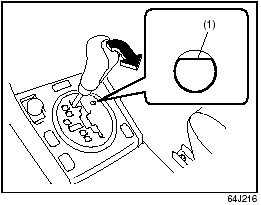Suzuki Grand Vitara: If the Engine Overheats
The engine could overheat temporarily under severe driving conditions. If the engine coolant temperature gauge indicates overheating during driving: 1) Turn off the air conditioner, if equipped. 2) Take the vehicle to a safe place and park. 3) Let the engine run at normal idle speed for a few minutes until the indicator is within the normal, acceptable temperature range shown by the white band between “H” and “C”.
 WARNING: If you see or hear escaping
steam, stop the vehicle in a safe place and immediately turn off the engine to let
it cool. Do not open the hood when steam is present. When the steam can no longer
be seen or heard, open the hood to see if the coolant is still boiling. If it is,
you must wait until it stops boiling before you proceed. Also, be careful not to
touch hot engine parts (radiator, water hoses, engine etc.).
WARNING: If you see or hear escaping
steam, stop the vehicle in a safe place and immediately turn off the engine to let
it cool. Do not open the hood when steam is present. When the steam can no longer
be seen or heard, open the hood to see if the coolant is still boiling. If it is,
you must wait until it stops boiling before you proceed. Also, be careful not to
touch hot engine parts (radiator, water hoses, engine etc.).
If the temperature indication does not come down to within the normal, acceptable range: 1) Turn off the engine and check that the water pump belt and pulleys are not damaged or slipping. If any abnormality is found, correct it. 2) Check the coolant level in the reservoir. If it is found to be lower than the “LOW” line, look for leaks at the radiator, water pump and radiator and heater hoses. If you locate any leaks that may have caused the overheating, do not run the engine until these problems have been corrected. 3) If you do not find a leak, carefully add coolant to the reservoir and then the radiator, if necessary. (Refer to “Engine Coolant” in the “INSPECTION AND MAINTENANCE” section.)

 WARNING:
WARNING:
• It is hazardous to remove the radiator cap when the water temperature is high,
because scalding fluid and steam may be blown out under pressure. The cap should
only be taken off when the coolant temperature has lowered.
• To prevent personal injury, keep hands, tools and clothing away from the engine
cooling fan and airconditioner fan (if equipped). These electric fans can automatically
turn on without warning.
If You Can Not Shift Automatic Transmission Gearshift Lever Out of “P” (PARK)

Vehicles with an automatic transmission have an electrically operated park-lock feature. If the vehicle’s battery is discharged, or there is some other electrical failure, the automatic transmission cannot be shifted out of Park in the normal way. Jump starting may correct the condition. If not, follow the procedure described below. This procedure will permit shifting the transmission out of Park. 1) Be sure the parking brake is firmly applied. 2) If the engine is running, stop the engine. 3) Make sure the key is in the “ON” or “ACC” position. 4) Remove the cover (1) on the hole. 5) With inserting the key or the flat end rod into the slot in the hole, shift the gearshift lever to the desired position. This procedure is for emergency use only. If repeated use of this procedure is necessary, or the procedure does not work as described, take the vehicle to your dealer for repair.
See also:
Mirrors
Inside Rearview
Mirror
Inside Rearview
Mirror
You can adjust the inside rearview mirror by hand so as to see the rear of your
vehicle in the mirror. To adjust the mirror, set the selector tab (1) to the day
position, then move the mirror ...
Battery
The condition of the battery is very important for quick starting and to keep
the vehicle’s electrical system working properly. Regular inspection and care are
especially important in cold weather.
NOTE:
● Memory data for settings made ...

 Jump Starting Instructions
Jump Starting Instructions